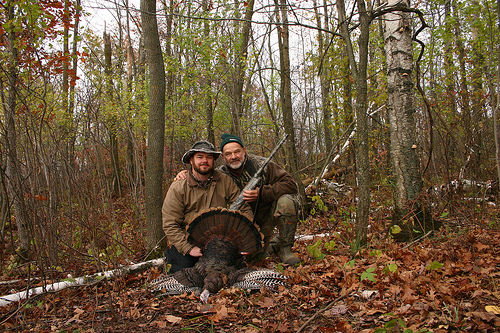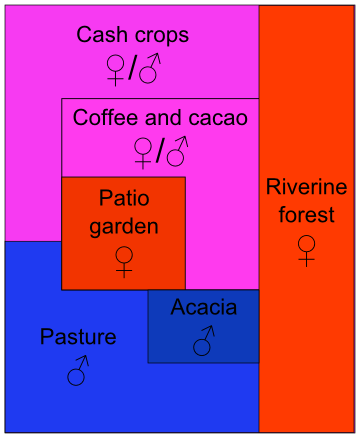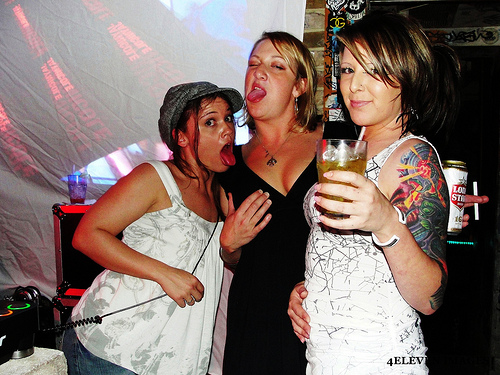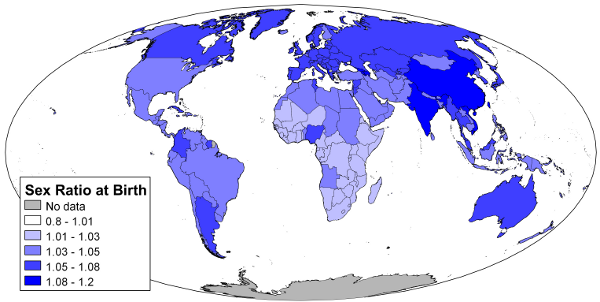Gender and Sexuality

The wilderness has long been a landscape associated with manliness. It's a place where men can go for "father and son bonding time" (as this photographer labeled it) and to become more manly through struggling against nature, such as by hunting.
photo from Flickr/oblivion9999
What is Gender? [link]
A first blush, it probably seems easy to define what we're talking about when we talk about gender. It's just men and women, and the differences between them, right? But things are not so simple, and explaining what actually constitutes gender is surprisingly difficult.
Before we can talk about the geography of gender, we need to get a handle on what goes into gender -- what its internal structure is. We can think of gender as being comprised of three components: physical sex, gender expression, and gender identity (Butler 1992, Mikkola 2008, Serano 2007).
Physical sex is the shape and functioning of our bodies. Physical sex is in turn made up of many sub-components -- the shape of one's genitals, the presence of secondary sex characteristics like breasts and beards, the balance of hormones like estrogen and testosterone, and the combination of X and Y chromosomes, to name a few of the more salient ones. These characteristics are not always clear-cut as "male" or "female" -- for example, at what point do we say a given organ passes from being a large clitoris to being a small penis? Further, they may not all line up in the same way in every person. Someone with an XY chromosome makeup may nevertheless, due to other genetic or hormonal variations, develop a vagina, breasts, and other characteristics usually associated with an XX chromosome makeup. Deciding whether to call a certain person's physical sex characteristics "male" or "female," and how to deal with people who don't fit what we imagine to be a "normal" male or female pattern, are cultural questions.
Gender expression is a set of behaviors, practices, and social roles that a person occupies. This gender role is typically assigned on the basis of the society's judgment as to the person's physical sex. Gender roles are commonly naturalized, that is, treated as given by nature rather than created by society. But in fact gender roles are extremely variable between societies. For example, in contemporary US culture, giving great attention to one's appearance is considered a female trait. A truly feminine woman is considered to be one who uses makeup and carefully selects the most attractive clothes, and men who do this may be denigrated as effeminate or "metrosexual." However, in many other cultures, attention to appearance, makeup, and clothes are male practices (Graeber 2001). There remains much debate about where to draw the line between what aspects of people's gender are the result of biology (physical sex) and which aspects are cultural (gender expression), but in general research has tended to expand the realm of culture. For example, it is widely believed that girls are not as good at math as boys, and that this difference is rooted in some biological difference between male and female brains. But in fact studies have shown that if girls are given the same amount of attention as boys, and are exposed to positive messages about their abilities rather than stereotypes that tell them they are bound to do poorly, girls' math achievement is equal to boys' (Else-Quest et al. 2010).
Mainstream US culture recognizes only two genders, male and female. However, many other cultures have additional gender categories, collectively referred to as third genders. The specific social role of third gender people varies greatly from society to society. For example, bissu is one of the five genders recognized by the Bugis people of Indonesia. Bissu have their own distinctive type of clothing and act as religious specialists with roles in ritual that cannot be perfomed by men or women (Peletz 2006). In the US, terms such as "genderqueer," "genderfluid," "androgyne," and "boi" are coming into use to describe third genders, though the definitions of these terms are not standardized.
Gender identity is a person's internal sense of themselves as a man or woman or another gender. For most people, their gender identity matches up with their physical sex and gender expression. We call this condition cis, which is sometimes lengthened to cissexual or cisgender. Because things match up so well, cis people are often not conscious of having a distinct gender identity. On the other hand, some people's gender identity does not match up with their physical sex and/or the gender expression that they are expected to exhibit. We call this condition trans, sometimes written out transsexual or transgender. Trans people should be referred to by the terminology and pronouns consistent with their gender identity -- thus, for example, someone whose gender identity says "I am a man" and who was born with a vagina would be a trans man.
The Geography of Gender [link]
Human populations typically have an equal number of females and males (the size of the third gender population is difficult to determine because the existence of these people is often not recognized by statistics, but in any case is fairly small). At birth, there are normally a slightly larger number of boys born, because the Y chromosome is slightly lighter than the X, giving sperm carrying a Y a slight advantage in fertilizing the egg. Over the course of life this ratio evens out because male physiology is less resistant to disease and stress, leading to a surplus of women over men in elderly populations.
Various social and cultural factors can further skew gender ratios in one direction or another. For example, war may result in a loss of men (this is generally seen as the reason why the Prophet Muhammad allowed Muslim men to take up to four wives, to ensure that all women had a husband despite the death of many men in battle). One notable example of a social factor altering gender ratios in the world today is the phenomenon of "missing girls" or "missing women" in Asia (Sen 1990). Looking at Figure 1, you can see that several countries (notably India and China) show a distinct surplus of boys being born over girls. As many as 100 million women may be "missing" -- that is, those women ought to exist if they were being born at a rate proportional to men.

Figure 2: Proportion of residents who believe men should work while women should tend the home, 2006. Map shows percent of survey respondents who agreed or strongly agreed with the statement "It is much better for everyone involved if the man is the achiever outside the home and the woman takes care of the home and family."
data from General Social Survey
Various explanations have been suggested for the "missing women." Parents of daughters will continue having children until they get a son, whereas parents of sons are more likely to stop rather than continuing to try to get a daughter too. Parents may neglect care and feeding of girls, making them more susceptible to death. They may also engage in sex-selective abortion, aborting female fetuses but not male ones. The root cause is a cultural preference to have a son who will carry on the family into the next generation and support his parents as they age. A daughter, on the other hand, would be expected to marry and become an asset to her husband's family. When a culture practices dowry -- the requirement that the bride's parents give large gifts of money and goods to the groom -- girls come to be seen as a burden on the family. Gender ratios become particularly skewed in richer, more urbanized areas, where the pressure to have a successful son, the expected size of a dowry, and the ability to obtain a sex-selective abortion are greater.
Many scholars and politicians are concerned about what will happen when these heavily-male generations come of age. In particular, there is much concern about the fact that since most of these men will be heterosexual, they will have difficulty finding a romantic partner. This could lead to an increase in sex trafficking and seeking brides from countries with more even gender ratios. Some also fear that a large population of men unable to start families will instead turn to violent ideologies.
In addition to examining the distribution of men and women themselves, we can also look at the distribution of features of gender expression. If gender expression is culturally variable, then it may be constructed in different ways in different areas. One example is Figure 2, showing the responses to a survey question about the gendered division of labor in different regions of the US. While equal proportions of the population of New England and the southern Atlantic coast may be women, the experience of being a woman is going to be quite different in a place where there is a strong expectation that you will be a homemaker, as compared to a region where there is not this expectation.
Gendered Spaces [link]
A critical concept in the geography of gender is the idea of gendered spaces. Gendered spaces are areas in which particular genders of people, and particular types of gender expression, are considered welcome or appropriate, and other types are unwelcome or inappropriate. Gendering of spaces is an important means by which social systems maintain the organization of gender. They reinforce particular ways of being a man or being a woman, and can maintain the relationships between men and women. (Note that while the commonly used term is "gendered spaces," we may be talking about things that would more technically be called "gendered places," "gendered landscapes," or "gendered environments").

Figure 3: Diagram of gendering of farm space in a village in the Dominican Republic. Colors and symbols show which gender has responsibility for the management of each area. Responsibility may not match up to who has control of the land, and who is required to perform labor in that area -- in this particular case, men control all of the land (sometimes jointly with women), and women are required to contribute labor to all areas (sometimes jointly with men).
based on a figure from Rocheleau et al. 1996
Some cultures make extensive and strict divisions of space into women's space and men's space. In subsistence agricultural societies, for example, farmland is often divided up between genders. Men control certain types of land to grow certain crops, while women get control of other land for other crops. Figure 3 shows an example of the gender division of a field in the Dominican Republic. The specifics of which lands and crops are assigned to which gender can profoundly shape the roles, and relative power, of men and women. For example, in many such societies women are assigned to the crops that are basic staples of the household, while men grow the cash crops that bring in money for the household -- giving men greater control of the family's finances, while women's roles as keepers of the household are reinforced. Changing circumstances can interact with the gendering of spaces to create conflict between men and women. For example, if a development agency creates opportunities to expand certain types of cash crops usually grown by men (in the interest of raising the region's economic prosperity), there may be an incentive for men to encroach on women's land to enhance their own profits. The result could be a greater degree of inequality between the genders (Rocheleau et al. 1996). For this reason, many development agencies have recently begun to specifically target things that are traditionally women's activities, in hopes of reducing gender inequality.
One very common form of gendered spaces is referred to as the public-private divide. The traditional view in most Western and Islamic societies is that private space belongs to women, while public space belongs to men. Thus, women should remain in the home and care for the family's own affairs. Meanwhile interactions between family groups and the wider world, in the public realms of the market and government, should be managed by men. This divide may be reinforced in various ways, from explicit legal barriers (such as the laws in some Islamic societies requiring women to wear concealing garments so that their presence doesn't create a distraction in male public space) to informal assumptions about people (such as that the food I bring to my public workplace for lunch must have been cooked for me in our private home by my wife). In many cases, it has historically been difficult for poor women and women of color to follow the gendered public-private divide, because they had to go out into the working world to support their families. Dominant groups then took this failure to follow the public-private divide as evidence that these women were not properly feminine (Collins 2000).
Gendered spaces are not simply assigned to men or women. They are typically assigned to particular forms of masculinity or femininity. Take, for example, public restrooms in the US and similar countries. The signs on the door simply say "men" and "women." But some types of men and women are excluded. In order to enforce the gender segregation of bathrooms, people whose gender expression does not conform to social expectations may be kicked out -- for example, women whose hair and clothing appears masculine or androgynous may be barred from the women's room. Transgender people also may face bathroom exclusion. A trans woman may not be regarded as a "real" woman, and therefore she may be prohibited from going in the women's room, while she faces the possibility of harassment if she enters the men's room (Curtis 2009).
Symbolic landscapes are also often highly gendered. In societies like the US and Australia, an important set of symbolic landscapes are the wilderness and the domestic sphere. These are closely associated with masculinity and femininity, respectively (Elder 2007). The wilderness is taken to be a place where men could prove and enhance their manliness through struggle against the elements. Women's role, on the other hand, was to maintain the virtues of civilization by tending to the domestic sphere in the home and settlements. This gendering of these symbolic landscapes was a significant part of the motivation for the establishment of national parks. People like Teddy Roosevelt wanted to maintain places where men could develop their manliness by "roughing it" and killing large animals, and feared that a loss of wilderness would lead to men becoming effeminate due to living their whole lives in civilized settings (Rome 2006). And these ideals survive today, for example in the Boy Scouts' idea that boys can be taught specifically manly virtues through a program centered around camping.
The gendering of spaces helps to reinforce a culture's gender norms (Cohen 2010). People who are in the "wrong" spaces are subject to punishments of various sorts, from teasing to violence. Which spaces receive which gendering sends messages about the proper character and duties of a person of a given gender (e.g. the wilderness is a masculine space, so men should be strong and tough). And gendered spaces can enable the dominant gender to retain control of valuable resources, as when important informal mentoring or making of business deals occurs at an all-male country club.
Sexuality and Sexualized Spaces [link]
A further consideration related to gender is sexuality. Sexuality refers to what sort of romantic and sexual practices a person wants to pursue. One of the most important aspects of sexuality has to do with the gender of the people one wishes to engage in romantic and sexual relations with. This leads most studies of the geography of sexuality to deal with people in terms of being heterosexual, homosexual, bisexual, pansexual, or asexual -- though one could also do a geography of BDSM versus vanilla sex, of monogamy versus non-monogamy, or of any other difference in sexual practices. The term "queer" is frequently used by geographers as an umbrella term for all non-privileged sexualities, though the term's origins as a slur mean that non-queer people should be careful about using it. In other cases, geographers use acronyms that attempt to list the major ways that people who are not cis and heterosexual define their identities -- the most common of which is LGBTQ (lesbian, gay, bisexual, transgender, queer), though the order of the letters may be changed and additional ones (e.g. A for asexual, or a second Q for questioning) may be added.

Figure 4: Ladies' Night: a Heteronormative Space. Bars and dance clubs are seen as good places for men to pick up women, and so they are often highly heteronormative. "Ladies' Night" takes this to an extreme, as bars offer drink discounts to encourage women to attend, on the theory that this will attract lots of heterosexual men who will pay full price for the chance to hit on said women.
photo from Flickr/4ELEVEN Images
Just as spaces may be gendered, they may be sexualized. Certain areas of the world are more or less welcoming to people of particular sexualities. Since heterosexuality is the privileged sexuality in the US, most spaces in the US are more welcoming to heterosexuals than to other people. LGBTQ people learn quickly that certain spaces may be physically dangerous if their sexuality becomes known, as some people will use violence to enforce the privileging of heterosexuality. Other spaces may subject them to ostracism, harassment, and unwanted intrusion on their private lives. The privileging of heterosexuality means that many spaces that are not explicitly exclusionary toward LGBTQ people are still heteronormative. A heteronormative space is one in which the organization of the space, and of the activities that take place within it, presume that everyone either has or wants an opposite-sex partner (Figure 4). In a heteronormative space, LGBTQ people may be unable to participate, or may need to ask for special exceptions to be made to accommodate their deviation from the norm (Valentine 1993). For example, many institutions -- such as single-sex college dormitories or prisons -- are gender-segregated in an attempt to stop attendees from engaging in, or being distracted by, the possibility of sexual liaisons. Those institutions may even organize certain defined events at which the genders are brought together to allow for sexual relations, such as the "mixers" held between a fraternity and a sorority. None of these arrangements treat the possibility of same-sex relations as equally normal (and may therefore react with particular hostility to gays and lesbians).
In response to the sexualizing of so many spaces in a society, LGBTQ people may try to construct their own spaces where their sexualities are accepted on an equal basis -- or even privileged over heterosexuality. Thus we see the establishment of gay neighborhoods in large cities, including gay-friendly businesses (Brown and Knopp 2008), as well as more radical experiments such as lesbian separatist communes in rural areas (Sandilands 2004).
Works Cited [link]
Brown, Michael, and Larry Knopp. 2008. Queering the map: the productive tensions of colliding epistemologies. Annals of the Association of American Geographers 98 (1): 40-58.
Butler, Judith. 1992. Gender Trouble: Feminism and the Subversion of Identity. New York: Routledge.
Cohen, David S. 2010. Keeping men men and women down: sex segregation, anti-essentialism, and masculinity. Harvard Journal of Law and Gender
Collins, Patricia Hill. 2000. Black Feminist Thought: Knowledge, Consciousness, and the Politics of Empowerment. New York: Routledge.
Curtis, Abigail. 2009. Panel backs transgender woman in restroom case. Bangor Daily News, May 19.
Elder, Catriona. 2007. Being Australian: Narratives of National Identity. Crows Nest, NSW: Allen & Unwin.
Else-Quest, Nicole M., Janet Shibley Hyde, and Marcia C. Linn. 2010. Cross-national patterns of gender differences in mathematics: a meta-analysis. Psychological Bulletin 136 (1): 103-127.
Graeber, David. 2001. Toward an Anthropological Theory of Value: The False Coin of Our Own Dreams. New York: Palgrave.
Mikkola, Mari. 2008. Feminist perspectives on sex and gender. Stanford Encyclopedia of Philosophy.
Peletz, Michael G. 2006. Transgenderism and gender pluralism in Southeast Asia since early modern times. Current Anthropology 47 (2): 309-340.
Rocheleau, Dianne, Laurie Ross, and Julio Morrobel. 1996. From forest gardens to tree farms: women, men, and timber in Zambrana-Chacuey, Dominican Republic. In Feminist Political Ecology: Global Issues and Local Experiences, ed. Dianne Rocheleau, Barbara Thomas-Slayter, and Esther Wangari, 224-250. London: Routledge.
Rome, Adam. 2006. "Political hermaphrodites": gender and environmental reform in progressive America. Environmental History 11 (3).
Sandilands, Catriona. 2004. Sexual politics and environmental justice: lesbian separatists in rural Oregon. In New Perspectives on Environmental Justice: Gender, Sexuality, and Activism, ed. Rachel Stein, 109-126. New Brunswick, NJ: Rutgers University Press.
Sen, Amartya. 1990. More than 100 million women are missing. New York Review of Books 37 (20).
Serano, Julia. 2007. Whipping Girl: A Transsexual Woman on Sexism and the Scapegoating of Femininity. Emeryville, CA: Seal Press.
Valentine, G. 1993. (Hetero)sexing space: lesbian perceptions and experiences of everyday spaces. Environment and Planning D: Society and Space 11: 395-413.
